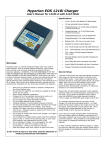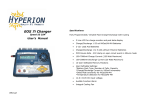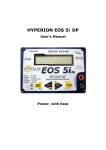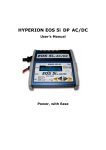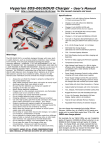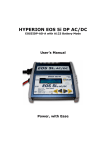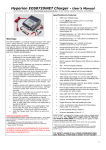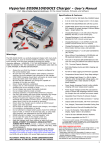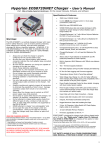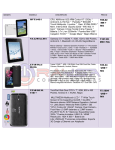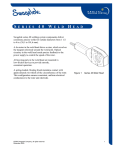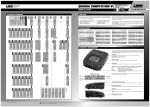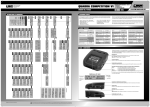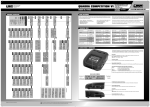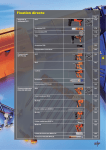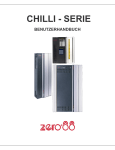Download 1210i manual - Aeromodelismo Serpa
Transcript
Hyperion EOS 1210i Charger User’s Manual Specifications: • 2-Line, 16-Char, Blue Backlit LCD Data Display • 10 User-definable Memory Positions • Warnings: The EOS 1210i is a carefully-designed charger with many built-in safety features, such as reverse polarity protection, input voltage error warning, and cell-count mismatch warnings for lithium chemistry batteries. HOWEVER, IT IS THE RESPOSIBILITY OF THE USER TO INSURE THAT THE CHARGER IS CONFIGURED AND USED IN A SAFE MANNER IN PROPER ENVIRONMENT. Note that as cell count of lithium batteries becomes higher, all warning systems become less accurate. As such, we strongly recommend the use of Hyperion LBA10 balancers when charging lithium batteries, and especially so at 4S or higher. LBA provide much additional safety, because the LBA monitors each individual cell. • • • • • • • • • • • • • • Always be sure that the charger is properly configured for the correct battery type. Be sure that the batteries you charge are capable of charge at the rate you select. Never charge batteries unattended. Charge only in a fire-resistant environment, such as on concrete or brick, rather than wood surfaces. Do not charge near easily flammable materials. Do not charge batteries inside a model. Charging outdoors is recommended whenever practical Use only high-quality gold 4mm bullet connectors for charge output cable connection to the charger. See “setup”. Insulate all Output connectors to eliminate the possibility of short circuit. Damage caused by output short circuit is not covered by warranty. Do not drop or cause other shock to the charger, nor subject it to moisture or water Do not attempt to charge battery packs made from different types of cells, a mixture of old and new cells, or cells made with chemistry not supported by the EOS 1210i Do not attempt to charge “non-rechargeable” dry cells. Do not open the case of the charger under any circumstances. Doing so will void the warranty. Keep the charger away from children or pets at all times. In the event of injury of any kind, seek the attention of medical professionals immediately. Charge/Discharge 1 to 12 cells Lithium Batteries (3.7V/cell nominal types) • Charge/Discharge/Cycle 1-30 cell NiCd/Ni-MH • Charge/Discharge 2-12v Lead Acid Batteries • Balancer Safe - 23V max out on open circuit • DataPort for Hyperion LBA10 Balancers • 0.1A -10.0A Charge Current (180 Watt Maximum) • 0.1A - 5.0A Discharge Current (50 Watt Maximum) • TCS - LiPo Terminal Capacity Selection 50%~100% • Rich Data Displays during and after charging and discharging • Input Cable with 4mm Connectors and Clamps • Output Cable Set Included, with 4mm Connectors • Integral, Thermostat-Controlled Cooling Fan General Setup: The EOS 1210i comes with male 4mm Bullet connectors (also known as ‘banana connectors’) attached to the power INPUT cables. These cables are appropriate for attaching directly to most high-quality AC-DC 12V power supply units, such as the BK Precision (USA) model 1692. Also included are large Terminal Clips with matching 4mm female bullet connectors, for attaching directly to 12V lead-acid batteries. Output side connector/cable assembly is also supplied. Carefully solder your preferred battery connector to the free ends. If you make up additional output cables, note that MINIMUM inner cable diameter should be 2.5mm (14ga) and MAXIMUM cable length is 20cm (8”). It is critically important that you use either a fully charged 12V lead-acid battery of adequate capacity - or a high quality AC-DC power supply in the range of 12V to 15V DC output, with minimum current rating of 8A. When charging high voltage batteries at high current an output rating of up to 25A may be required. If you have any trouble charging after confirming that input and output cables are properly connected and of the proper materials, be sure to check the charger on an automotive battery. Many problems are associated with poor quality or inadequate switching AC-DC power supplies. If, after carefully reading the following pages on usage, you have any difficulty using the charger please refer to the final pages for troubleshooting guide and warranty terms. It is well to carefully check your charger before making a return, as problems in setup, cabling, or power supply are much more common than defects in the charger. Chargers returned by the user and later found not defective will only be returned to the user at the user’s expense. Memory Position and Settings per Battery Type The “Auto” modes for NiCd and NiMh battery types are preferred whenever you have a battery pack made from quality cells and in good condition and balance. The EOS 1210i charges NiCd and NiMH in Auto Mode based on an intelligent algorithm which maximizes performance and minimizes charge time. These two pre-configured memory positions cannot be edited: A1 - NiCd Automatic A2- NiMH Automatic Ten additional memory positions - M0 to M9 - allow you to choose parameters for charging or discharging, such as battery type (NiMH, NiCd, LiPo, Lead-Acid), battery capacity, discharge rate, cutoff voltage or temperature, and more. Charging - Let’s try it once to learn it…. ENTER: Select Memory Position to change / Charge Start, Charge Stop SETUP: Selects parameters for editing in turn UP/DOWN: Scroll through memory positions / Change parameter settings After connecting the charger to a suitable power source, the LCD monitor will show the configuration used in the previous charging session. After the welcome screen, press ENTER then the UP button to scroll through the pre-set memory positions. Stop on M8 (NiCd 24 cell). Press ENTER to choose Memory slot M8. Now press SETUP, and you will see that the text for battery type is blinking (“NiCd”), and screen title has changed to BATTERY SETUP. Press the UP (or DOWN) button to scroll through battery type selections. Press SETUP again at LiPo to set the battery type to Lithium Polymer; the cursor then moves to Voltage Selection. For lithium polymer, voltages are listed as number of cells in series, or “S”. Press the UP key to choose “4S”, then press SETUP again. Press DOWN repeatedly to set Battery Capacity to 2500 (mAh), then press SETUP. The display changes from BATTERY SETUP back to MEMORY SELECT. Now, press the DOWN button to move away from MEMORY SELECT screen, and go to CHARGE MODE screen. Note that CHARGE RATE (C:) will be 2.5A to start. This is default behavior, and is a “One C” charge rate based on the 2500mAh capacity you set earlier, at the BATTERY SETUP screen. Now keep pressing the UP key, until the Charge Rate display stops changing. You will see that it allows you to set up to 5A charge rate maximum, which is “2C” for our 2500mAh battery example. Note: Hyperion batteries all support charge rates of 2C+. But do check that your battery brand is capable of charge in excess of 1C before making such selections. See Addendum later as to why rates higher than 2C should be avoided. Now, press SETUP again, to select estimated Terminal Capacity of Charge. Press the DOWN key, until the display shows 90%, then press SETUP. Note: normally this setting is 100%, but we have altered it just to see how it is done, for training purposes. (see notes on TCS later in Addendum) At this point, you have altered memory slot #8 to charge 4S 2500mAh LiPo batteries at 2C rate, to 90% of battery capacity. We should still be at the CHARGE MODE screen. You should not have anything connected to the output port at this time. Now, we are going to press the ENTER key to start “charging”, but will get a CONNECT ERROR from the charger; that’s ok, but do be ready to press ENTER again to stop the Warning buzzer. So press ENTER now, then ENTER again after the warning tones. Finished testing? Ok, now you know how to configure your new EOS 1210i, to charge a lithium battery pack! More About BATTERY SETUP and CHARGE MODE Screens Consult the documentation or labels provided with your battery to determine the correct capacity setting. It is very important to get this right, as the charger uses the capacity setting to determine nominal charge rate (amperage), TCS percentage, and safety termination. Incorrect settings could damage the battery, and could even cause an accident. Lithium: Please be absolutely sure that you know the type of lithium battery you are charging, the capacity in mAh, and the number of cells wired in series! The EOS charger is only for lithium with 3.7V per cell nominal. If your battery does not have a number for “S” count on the label, like “3S”, but does show the nominal voltage, use the chart below to set the correct “S” when charging: Number of Lithium Cells Wired in Series (S) 1S 3.7V 2S 7.4V 3S 11.1V 4S 14.8V 5S 18.5V 6S 22.2V 7S 25.9V 8S 29.6V 9S 33.3V 10S 37.0V 11S 40.7V 12S 44.4V For Lithium (and also NiCd, NiMH) CAPACITY is given in mAh (at BATTERY SETUP screen). Selection is in increments of 100mAh. If your battery does not fall on an exact division of 100 - for example battery is rated 670mAh - you should choose the next closest setting. In our example, 700mAh would be appropriate. CURRENT is set in Ampere (at CHARGE MODE screen), so divide mAh by 1000 to get Amperage. For 700mAh, current is 0.7A for 1C, up to 1.4A for 2C max. For 1800mAh, 1.8A~3.6A and so on…. Lead Acid Batteries: Set Voltage of the battery, Amp Hour (Ah) rating of the battery at BATTERY SETUP screen, and Charge Current at CHARGE MODE screen. Consult the battery manufacturer’s documentation to determine all of these settings. Number of Cells in Lead Acid Battery Pb 1 cell 2.0V 2 cells 4.0V 3 cells 6.0V 4 cells 8.0V 5 cells 10.0V 6 cells 12.0V For NiCd and NiMH: Set Voltage of the battery, Number of Cells (C), and Capacity in mAh at BATTERY SETUP screen, and Charge Current at CHARGE MODE screen. If you only know the nominal rated voltage of the pack, but not the number of cells, divide voltage by 1.2 to get cell count: Example: 9.6V / 1.2 = 8 , so there are 8 cells in the pack. At the NiCd/NiMH CHARGE MODE screen, there is a setting for \ : Delta V (sensitivity to voltage change for charge termination). If you have no good reason to change the defaults, don’t touch this. By default, NiCd is 8mV/C and NiMH is 4mV/C, in case you change it by mistake… Note again that in AUTO modes for NiCd (A1)and NiMH (A2), you do not need to set anything. Just connect the battery after choosing the correct Auto Mode, and press ENTER to start charging. Other Screens and Settings DISCHARGE MODE: D : Discharge rate in ampere (A), 0.1A increments xV/CELL : “x” is the stop discharge voltage cutoff per cell Note: Typically xV/CELL would be 0.9V for NiCd/NiMH, 3.0V for Lithium. However, except for testing the condition of a lithium pack, discharge or cycling of Lithium batteries has no advantage and is best avoided. CYCLE MODE: DCH/CHG : Choose to Discharge first, then Charge OR CHG/DCH : Choose to Charge first, then Discharge TIME : Number of cycles to perform ( 1 = one cycle, 2 = two cycles…) USER CONDITION SETUP: The four starred *settings below are global and affect all memory positions. Push ENTER when at the USER CONDITION SETUP screen to access these four sub menus, then UP/DOWN to make changes (if desired), then ENTER again to move to the next screen (SETUP button is not used at all). *TEMPERATURE: When the optional temperature probe (HP-EOS1210I-SEN) is attached to battery and charger, the temperature in degrees Celsius at which charging will terminate. Use UP/DOWN buttons to choose an appropriate temperature in a range from 10 to 55 degrees. Press ENTER to continue. *TRICKLE CHARGE CURRENT: (does not apply to Lithium batteries) Trickle charge is a low-current maintenance charge that continues after the normal high-rate charge cycle is finished. AUTO : Determined by charger algorithm (best in most cases) 0mA : OFF - No trickle charge 100mA~500mA trickle charge current, in 100mA increments. *DELAY BETWEEN CHARGE/DISCHARGE: Applies only when CYCLE MODE is in use, from 1 to 30 minutes in one-minute increments. *SOUND VOLUME: OFF, or one of five choices for tone. Press UP/DOWN to hear each tone type. ENTER to choose and exit. (note: it says “volume”, but it is really tone type…) Once you are satisfied that all the settings in the current memory position are correct for your battery, you are ready to charge, discharge, or cycle your pack! Note: When an LBA10 or compatible balancer is not connected to the 1210i via DataPort, the initial screen after charge is started will recommend use of the LBA, for best safety. • • • • Use the UP/DOWN buttons to select to the CHARGE MODE screen. Attach your battery pack to the charger outputs using proper connector and cable assembly. Cable to charger, then Battery to Cable. Press the ENTER button to start charging. You can press the UP/DOWN buttons during charging to increase/decrease the charge rate. When charging is complete, the charger will issue the tone you selected (if not OFF) and flash display. HOLD DOWN the ENTER button (0.5 sec+) to stop charging early, if desired. USE of DISCHARGE or CYCLE MODE Functions follows the same button procedures as CHARGE. DATA VIEW for Battery & Charger Conditions During or after charge/discharge, there is much information available within the DATA VIEW screens. *During Charging: Press SETUP once, then ENTER to scroll through the various Data Screens. *After charging: From any top menu, press UP/DOWN to reach DATAVIEW, then ENTER to see each sub-screen: *INPUT / OUTPUT voltage at the charger *TEMPERATURE SET: Temp Cutoff Setting PEAK: Peak temperature recorded TEMP: Current temperature *CHARGE PEAK: Voltage CHARGE TIME in minutes and seconds mAh accepted by the pack during charge *DISCHARGE Avg. Voltage, discharge time, mAh from pack *CYCLE DATA (UP/DOWN to cycle the 5 previous data sets) mAh input and output for each charge/discharge cycle *CELL BALANCER VOLTAGE (with LBA10 Cell Balancer connected via DataCable) Average and Current Voltage *INDIVIDUAL LIPO CELL VOLTAGE Screen #1, Cells 1~6 (single LBA with compatible 1~6S battery pack) Screen #2, Cells 7~12 (two Networked LBA with two compatible 1~6S battery packs in series) Additional Information - Addendum TCS Feature: (Terminal Capacity Selection for Lithium Batteries) This feature is selected at the CHARGE MODE screen. Estimated Capacity (EP) can be set from 50% to 100%. The charger uses your setting for Battery Capacity in addition to sophisticated measurements and calculations to make a close estimate for the currently charged capacity in the pack during charging. There are two good reasons why you might want to charge a Lithium Battery to something less than full capacity. The first is for long-term storage. Lithium batteries are best stored after charging to 55%~60% of nominal capacity. So this use is easy to understand. The second aim is to get more flight time in during a typical day at the field, by stopping the charge when the battery is 85% to 95% full, for example. But, reasonably, one might ask: “Wouldn’t that only speed the charge process by about 5~15%? Actually, no. Charging to 90% (for example), rather than 100%, pays a much larger bonus in saved charge time…. Lithium Polymer batteries are a bit special, in that they must use a “Constant Current - Constant Voltage” charging system. Initially, a fully depleted battery (i.e. ~3.0V/cell) will be charged at constant “full current”, according to your setting for Current at the CHARGE MODE screen. However, as the voltage of the pack rises, current must be steadily reduced. Toward the end of the charge, voltage becomes nearly constant as 4.2V per cell is approached, and current is reduced to a trickle. This means that charging the last few mAh back into the pack takes a LOT more time than the first few mAh did… But Lithium Batteries are very light considering the large capacity they hold; so, if you want to charge quickly and get back in the air, charging to less than full capacity may be a good strategy. For example, the EOS 1210i requires roughly 39 minutes to fully charge a Hyperion lithium battery, when set to the max rate of 2C. At the same 2C rate, but with TCS set to 90%, the same battery can be charged in as little as 27 minutes, saving 30% of the original charge time for a sacrifice of 10% capacity. And for many pilots - who may usually land with 20% or more capacity remaining in the pack anyway - there is essentially no sacrifice at all… We suggest that you start by flying fully charged packs, and measure how much remains in the pack after a flight, by checking data after a flight to see what percentage you actually use on average (mAh put back IN to the pack during charges, compared to total pack capacity, several times). That will give you a good idea how much you can reduce Charged Capacity, and still leave a little margin extra. Note and keep in mind that the rolling TCS estimation of charged capacity is better as the pack nears full charge. That is, at the 90% mark the estimation is very accurate, but at 50% mark is likely less accurate. Note also that the EOS 1210i will NOT automatically terminate the charge when your pre-set percentage is reached. Instead, it sounds a unique double-tone repeatedly, for an interval of 10 seconds. It is up to the user to manually terminate the charge at that point, or to do nothing and allow the charge to continue until 100% is reached. This is a safety feature to insure that packs are not inadvertently undercharged. And since the point of speed charging is that you want to fly NOW, it is unlikely that you would miss the double tones when they do sound, as you are waiting nearby to fly…. Charging in Excess of 1C Rate: Every Hyperion lithium polymer battery ever produced is capable of reliable charging in excess of 2C. Yet, until this document, Hyperion has only ever specified 1C charge rates. Why? Because extensive test and our experience have shown the following: • • • • • • Charge voltage in excess of 4.2V/cell is damaging to high-rate (15C+) lithium cells in particular The potential for damage from over-volt charging increases with charge rate Tests of other-brand chargers prove that many are poorly regulated, and that even some of the more expensive units regularly overcharge batteries. We can only be assured that Hyperion chargers will regulate properly (test one…) TCS set to ~98% adds extra insurance when charging at high rates. Tests show slightly longer life when TCS is used this way. Therefore it was in our interest to specify 1C max until this time, as now we have the powerful 1210i charger with 2C max rate, TCS, and Hyperion’s typically excellent voltage regulation. Note: These are the C rates for which NO degradation was found in Hyperion Lithium Packs: (Tested at 2.5, 2.75, 3.0C) HP VX: 3.0C HP CL 16C: 2.75C HP CL 20C+: 3.0C If 2C is Good… Why not 3C? 2C is the sensible limit for fast charging lithium polymer. Due to the CC/CV nature of the lithium charging process, the returns from increasing charge rate diminish very quickly after 2C. That is, total charge time is only a couple minutes shorter at 3C compared to 2C, yet charge rate has to increase 50% for that small gain. Given this, the risk/benefit equation lands squarely on the side of 2C max rates. Additionally, Hyperion has a responsibility to protect the interests of our customers. Since many batteries are not capable of charging reliably past 2C, chargers which do allow 3C charging are much more likely to cause damage to batteries, or even accidents. It is simply too easy to make a mistake with the Charge Rate setting, and there are no electronic safeguards which can be reliably employed against making such a mistake. Finally, most chargers that are theoretically capable of 3C charging can only do so for relatively low-S, low-capacity packs, due to inadequate max power and/or current capability. (see below for more on max power) If using other than Hyperion lithium packs, consult your battery’s documentation for allowed C rates, before exceeding 1C charge rates. Charge Amps vs. Charge Watts The EOS 1210i is rated for 12S, 10A, with power limit of 180W. These ratings make it one of the most powerful battery chargers in the world today, and the few competitors it does have typically cost two to four times as much. However, please note that a 10A maximum does NOT mean that every battery pack can be charged at 10A. The total power limit of 180W will determine where the current limits lie at higher cell counts, and the 10A limit determines total power output at low cell counts. The table at right assumes that the pack is fully depleted at start of charge, and the capacities shown have been rounded up/down slightly to make it easy to follow. Variations in pack type, state of charge, wiring employed, or presence of balancer devices may all impact on the observed charge rate initially, but will not affect total charge time greatly in most cases. The left column shows the lithium cell count in the pack. The middle column shows the CAPACITY that can be charged at 1C per number of cells (S). The right column is the same, but at 2C rate. Taking 6S packs as an example, you could charge a pack of 7900mAh at 1C, or a pack with half that capacity 3950mAh - at 2C. Either way, the charger will be putting out about 7.9A avg. during the initial portion of the charge curve… So, you can see that even with a single EOS 1210i, you can charge at 2C, or nearly 2C, for some large lithium packs. For example, packs in the range of 4S~6S, 3700~5000mAh are typically used for models in the “engine” .40ci to .90ci range, or their equivalent (lighter versions) in Electric, such as Hyperion Extra 260 40e or Super Chipmunk 70e… You can even charge a 4000mAh 12S pack at 1C. However, if you need a high-S, high-capacity lithium pack AND want to charge it in 27 to 40 minutes, the Hyperion system of two packs wired in series really becomes helpful. That allows you to separate the packs for charging on two sets of EOS1210i chargers mated to separate EOS LBA10 balancers (see LBA10 manual for details on two-charger setup), and charge each half at 2C, or very nearly 2C. And do remember that even 1.7C is a good deal faster than charging at 1C; much of the speed benefit is in the rise from 1C to about 1.7C… Note that you can ignore “C” calculations for all practical purposes. Just set the charger to “2C” rate, and it will automatically settle on the actual maximum (lower) rate, if there are power constraints. As an aside, the 1210i Cooling Fan will turn on if needed. Don’t worry if it doesn’t! LBA DATAPORT FEATURE The DataPort is a 3-pin output which fits the option cable #HP-EOSLBA10-DPC. See the label to locate the DataPort on the right side of your EOS charger. There are two main functions of the DataPort connection to LBA10 balance adapter: *The LBA communicates with the charger, giving notification when balance charging is completed, or when an error is detected. In both cases, the LBA tells the charger to shut down. This insures maximum safety, and saves the user from having to manually push the charger STOP (enter) button to stop the charge-end or error tones. The lithium battery should be disconnected from the LBA as soon as possible after charging is completed. * The DataPort version EOS chargers, when connected to LBA10 balancer via cable #HP-EOSLBA10-DPC, allow the user to monitor the individual voltages of each battery cell during the charge process. This is an important addition to pack diagnostics, as one is able to see the exact balance status of the battery pack (or packs, when LBA10 is in NET mode). To view individual cell voltages during the balance charging, connect a DataPort Cable (DPC) between Charger and LBA10 as shown by the Green line in diagram below. No matter if single or networked LBA, connect DPC to Master LBA. Note that DPC Port is on right side of EOS 1210i charger, not left as is shown in this generic diagram… TROUBLESHOOTING (1) Check again that the battery you are trying to charge and the settings on the EOS 1210i match. Battery type (such as NiMH or Lithium), battery capacity, number of cells (charge voltage), and charge rate must all be correct. (2) Check that the input cable and output cables: *Have proper connectors in good condition *Are not frayed, worn, cut, or damaged *Are the proper gauge (2.5mm, 14ga) *Are proper length - 20cm (8”) on output side (3) Attach the charger input connectors to a 12V automotive battery that is in good condition and fully charged. Wiggle the Terminal clips into the battery posts to insure that you have a good connection. Many charger problems are due to poor quality or inadequate switching AC-DC power supplies, so this test is necessary to eliminate those from the list of suspects. (4) Try another model battery for charging. If your RC battery is in poor condition, over discharged, or in some other way defective the charger may correctly refuse to charge it based on safety algorithms. (5) Try another RC battery type. For example switch to a NiMH battery if you are failing to charge Lithium types. Success with one type but failure with another generally indicates that the charger is working properly. The failing battery type is almost certainly in poor condition, then, or you have improperly set the charger for it. (6) Contact your dealer with full details and description of the problem, including the type of input power source, RC battery type and cell count, and history of the charger - that is, has the charger been working properly before, or failing from new condition? WARRANTY HYPERION Chargers are guaranteed to be free from defects in materials and workmanship for a period of one calendar year from date of purchase. Damage due physical shock (dropping on the floor, etc), inappropriate power supply (automotive battery charger, etc!), water, moisture, and humidity are specifically NOT covered by warranty. Your selling dealer is your first point of contact for warranty issues. Return postage costs are the responsibility of the user in all cases. Submit copy of original receipt with the return. Returned units should be examined by the Hyperion dealer’s tech department within 2 weeks of arrival, maximum, and contact made with the user to explain the findings. REPAIR/REPLACEMENT DUE TO NON-WARRANTY ISSUES: Due to the nature of the miniature electronics employed, and high cost of hand labor and shipping involved, it is not economically feasible to repair EOS chargers in most cases. Instead, we offer a blanket exchange policy at 50% of the US$ suggested retail price (plus any taxes due in your area, and return shipping). IN the event that your charger is damaged and warranty will not apply, please contact your selling dealer to obtain the correct return shipping address, for exchange under this program. Enjoy the Power! The Hyperion Team






